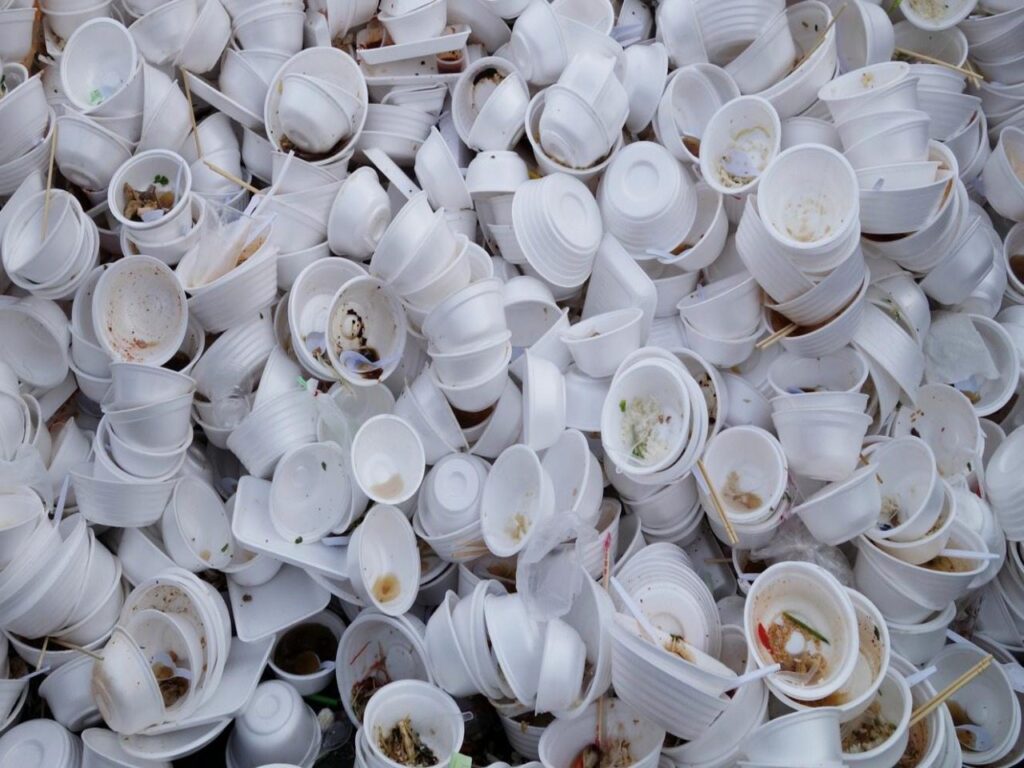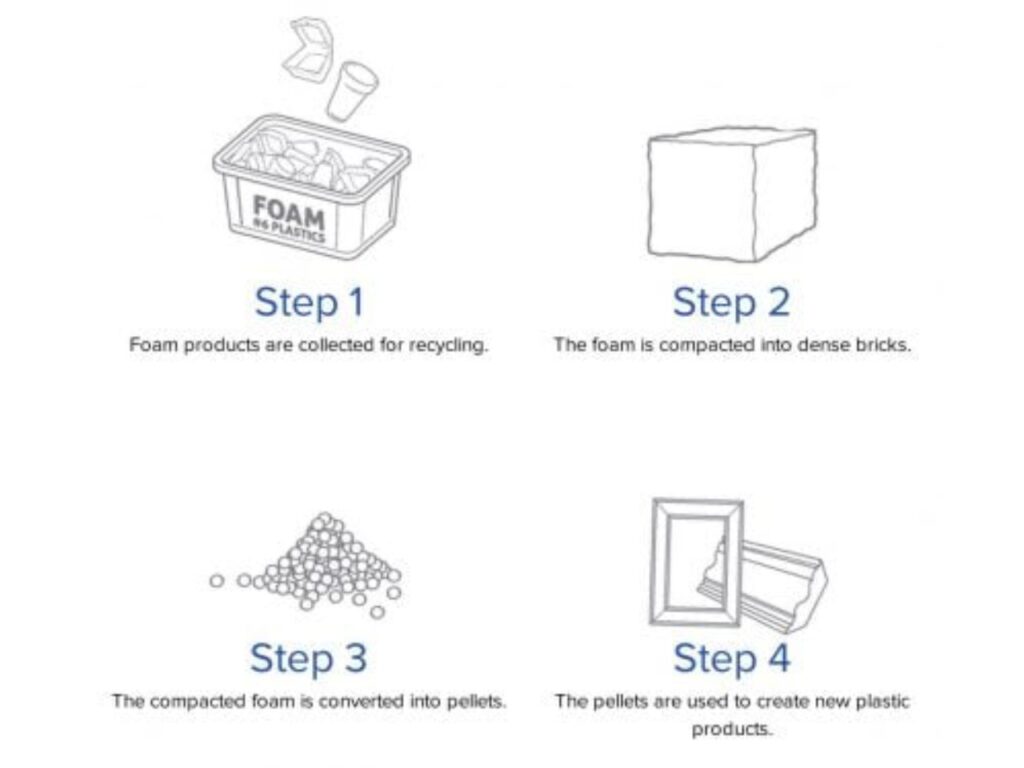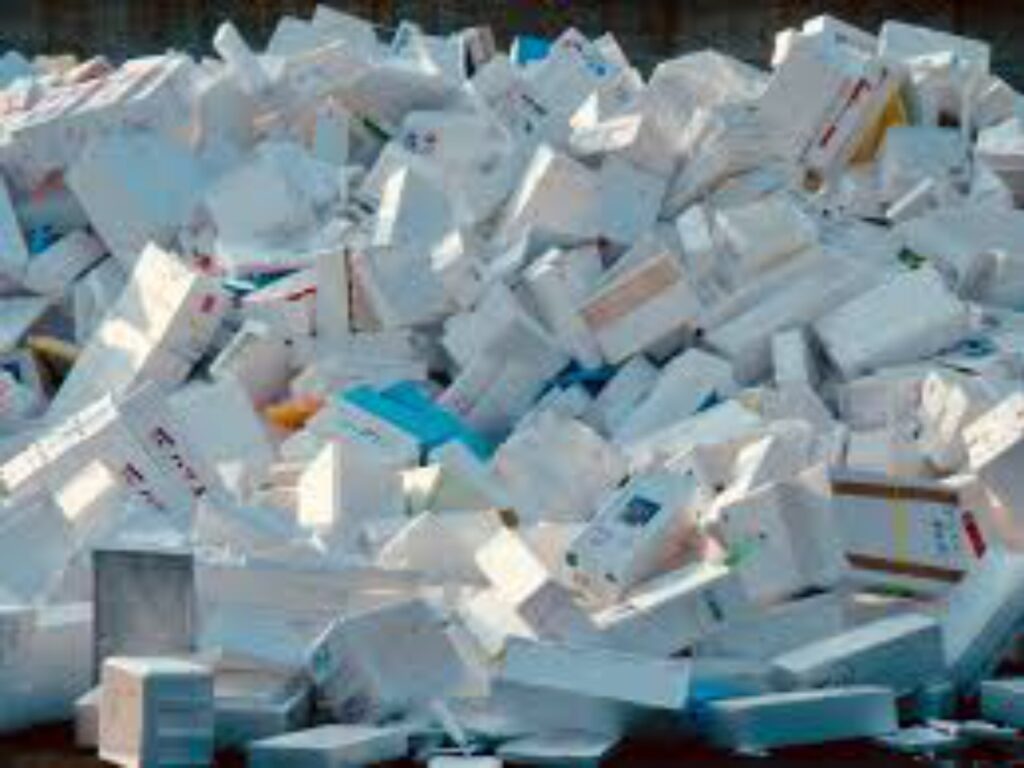When you unpack a new television or receive a food delivery in those familiar white foam containers, you’re holding one of modern packaging’s most controversial materials: Styrofoam.
The question “Is Styrofoam recyclable?” sparks heated debates among environmentalists, waste management experts, and everyday consumers alike.
Styrofoam—technically known as expanded polystyrene (EPS)—has become ubiquitous in our daily lives while simultaneously becoming public enemy number one for many eco-conscious individuals.
Its lightweight nature, excellent insulation properties, and low cost make it incredibly useful, but these same qualities create significant recycling challenges.
Whether you’re a concerned consumer, sustainability professional, or just someone tired of staring guiltily at that growing pile of foam packaging, this article will give you the knowledge to make informed decisions about Styrofoam use and disposal.
What Exactly Is Styrofoam?

The Chemistry of Polystyrene Foam
At its core, polystyrene is a petroleum-based plastic (polymer #6) composed of long chains of styrene monomers. When manufacturers create expanded polystyrene foam, they:
- Start with polystyrene resin beads
- Use steam and a blowing agent (historically CFCs, now usually pentane or CO2)
- Expand the beads to about 40 times their original size
- Mold them into blocks or shapes
The result is a material that’s about 95-98% air by volume, which explains its incredibly lightweight nature.
This air content is also what makes recycling so challenging—you’re dealing mostly with empty space rather than actual material.
Types of Polystyrene Foam Products
Not all polystyrene foam is created equal when it comes to recycling potential:
- Expanded Polystyrene (EPS): The classic white foam used for packaging, disposable food containers, and coffee cups. This is what most people picture as Styrofoam.
- Extruded Polystyrene (XPS): The blue or pink foam boards used in construction for insulation. More dense than EPS.
- Polystyrene Paper (PSP): Thin foam sheets used for meat trays and egg cartons.
- High-Impact Polystyrene (HIPS): A more rigid form used for things like CD cases.
The recycling processes and availability differ significantly between these types, with EPS being the most problematic.
Why Is Styrofoam So Difficult to Recycle?

The challenges with recycling Styrofoam stem from its fundamental physical and economic properties. Let’s examine the key obstacles:
Volume vs. Weight: The Transportation Problem
Imagine collecting a truckload of Styrofoam packaging. While you might fill an entire garbage truck with the material, when compressed, it might weigh less than 100 pounds.
This creates an economic nightmare for recycling programs:
- Transportation costs are based on volume, not weight
- You’re essentially paying to ship air
- The energy and emissions from transport can outweigh recycling benefits
Most municipal recycling programs can’t justify the expense of collecting and transporting such a bulky, lightweight material.
Contamination Concerns
Styrofoam used for food packaging presents additional challenges:
- Food residues are difficult to completely remove
- Grease and oils can compromise the recycling process
- Cleaning requires significant water and energy
- Even small amounts of contamination can ruin entire batches
This is why many recycling programs only accept clean, white packaging foam and exclude food service items entirely.
Market Limitations for Recycled Polystyrene
Unlike materials like aluminum or PET plastic, there isn’t a strong, consistent market for recycled polystyrene:
- The recycling process is more complex than for other plastics
- Virgin polystyrene is relatively inexpensive to produce
- Quality degradation occurs with each recycling cycle
- Limited applications for the recycled material
Without stable end markets, recycling programs struggle to justify the collection effort.
Breakdown of Styrofoam Recycling Challenges
| Challenge | Impact | Possible Solutions |
|---|---|---|
| Bulkiness | High transportation costs | On-site compaction |
| Food contamination | Limits recyclable items | Better cleaning systems |
| Low density | Poor economics | Volume reduction tech |
| Market fluctuations | Unstable recycling programs | Government mandates |
| Mixed materials | Processing difficulties | Better product design |
Current Methods for Recycling Styrofoam

Despite the challenges, several methods exist for recycling polystyrene foam. The availability of these options varies widely by location.
Mechanical Recycling
This is the most common form of Styrofoam recycling:
- Collection: Clean EPS is gathered from businesses or drop-off centers
- Compaction: Special machines compress the foam, removing air
- Shredding: The material is broken down into smaller pieces
- Extrusion: Melted and formed into pellets
- Manufacturing: Pellets are used to make new products
Mechanical recycling can reduce volume by up to 90%, making transportation feasible. The resulting pellets are used to make:
- Picture frames
- Office supplies
- Decorative moldings
- New foam packaging
- Insulation materials
Chemical Recycling (Advanced Recycling)
Emerging technologies are taking polystyrene recycling to the next level:
- Pyrolysis: Heating polystyrene in an oxygen-free environment breaks it back down to styrene monomers.
- Dissolution: Using solvents to dissolve the foam, then separating out impurities.
- Depolymerization: Chemical processes that return the plastic to its original chemical building blocks.
These methods can theoretically recycle polystyrene indefinitely without quality loss, but they’re currently expensive and not widely available.
Energy Recovery
In some waste-to-energy facilities, Styrofoam can be burned to generate electricity. While controversial, this can be preferable to landfilling when:
- Proper emission controls are in place
- No recycling options exist
- The material can’t be reused
However, many environmental groups oppose this method due to concerns about air pollution.
Drop-off Recycling Programs
Several organizations have established specialized Styrofoam recycling networks:
- Foam Recycling Coalition: Supports expanded polystyrene recycling in the U.S.
- EPS Industry Alliance: Maintains a directory of recycling locations
- Municipal Programs: Some forward-thinking cities offer periodic collections
These typically accept clean, white packaging foam but exclude food service items.
Where Can You Recycle Styrofoam?

Finding Styrofoam recycling options requires some research, as availability varies dramatically by location. Here’s how to navigate the system:
Checking Municipal Resources
- Visit your city or county’s waste management website
- Look for “hard to recycle materials” or “special waste” sections
- Call your local recycling coordinator for specifics
- Check for periodic collection events
Some progressive municipalities like San Francisco and Seattle have established regular EPS recycling programs.
Retail Take-Back Programs
Certain retailers accept Styrofoam packaging for recycling:
- UPS Stores: Some locations take packing peanuts
- Local Packaging Stores: Often have foam recycling bins
- Electronics Retailers: May take TV/computer packaging
Always call ahead to confirm participation and accepted materials.
Mail-Back Services
For those without local options, several companies offer mail-in recycling:
- Foam Cycle: Provides prepaid shipping labels for EPS
- Earth911: Maintains a recycling location database
- Plastic Film Recycling: Some accept certain foam types
Be aware that shipping costs may outweigh environmental benefits for small quantities.
Preparing Styrofoam for Recycling
To maximize chances of successful recycling:
- Clean It: Remove all tape, labels, and food residue
- Separate It: Keep white packaging foam separate from colored or food service foam
- Dry It: Ensure no moisture remains in the material
- Check Requirements: Follow local guidelines precisely
Contamination is one of the main reasons recyclers reject Styrofoam loads.
The Environmental Impact of Styrofoam Waste
Understanding why Styrofoam recycling matters requires examining its full environmental footprint.
Landfill Persistence
- EPS doesn’t biodegrade; it just breaks into smaller pieces
- Estimated to take 500+ years to decompose
- Occupies disproportionate landfill space due to its bulk
Marine Pollution
- Lightweight foam easily escapes waste streams
- Breaks down into microplastics that marine life ingest
- The Great Pacific Garbage Patch contains significant polystyrene
Production Footprint
- Made from non-renewable petroleum
- Manufacturing releases hazardous air pollutants
- Blowing agents have historically contributed to ozone depletion
Carbon Impact
While Styrofoam’s excellent insulation properties can reduce energy use in buildings and food transport, its full lifecycle impact remains concerning:
- High emissions from production
- Transportation impacts due to bulkiness
- Persistent waste issues
Innovative Alternatives to Traditional Styrofoam
As recycling challenges persist, researchers and companies are developing exciting alternatives:
Plant-Based Foams
- Mycelium (Mushroom) Packaging: Grown from fungal roots, fully compostable
- Cornstarch Peanuts: Dissolve in water, used as packing material
- Bagasse: Made from sugarcane fiber, good for food containers
Advanced Bioplastics
- PLA (Polylactic Acid): Derived from corn starch or sugarcane
- PHA (Polyhydroxyalkanoates): Produced by microorganisms
- Cellulose-Based: Using wood pulp or agricultural waste
Reusable Systems
- Returnable Shipping Containers: Durable alternatives to single-use foam
- Inflatable Air Pillows: Reusable protective packaging
- Fabric Wraps: For item protection in transit
Improved Traditional Options
- Paper-Based Cushioning: Honeycomb designs for protection
- Corrugated Bubble Wrap: Paper alternative to plastic
- Molded Pulp: From recycled paper, compostable
What Can You Do?
While systemic change is needed, individual actions collectively make an impact:
Reduction Strategies
- Refuse Unnecessary Foam: Request alternative packaging when ordering
- Choose Foam-Free Products: Support businesses using sustainable materials
- Buy in Bulk: Reduces individual packaging needs
Reuse Ideas
- Shipping Material: Save clean packing peanuts for future use
- Craft Projects: Use for model building or insulation
- Gardening: Drainage layer in potted plants
Responsible Disposal
- Research Local Options: Use Earth911’s recycling locator
- Participate in Take-Back Programs: When available
- Advocate for Change: Push for better recycling infrastructure
Conclusion
Technically, polystyrene foam can be recycled through various mechanical and chemical processes.
Practically, recycling access remains limited due to economic and logistical challenges.
Key takeaways:
Specialized recycling exists but isn’t universally available
Clean, white packaging foam has the best recycling prospects
Food-contaminated foam is rarely recyclable
Alternatives are emerging that may eventually replace EPS
Consumer pressure drives change in both recycling and materials innovation
The most sustainable approach combines:
- Reducing unnecessary Styrofoam use
- Reusing foam when possible
- Recycling through proper channels when available
- Supporting systemic solutions and alternatives
As technology improves and environmental priorities shift, polystyrene recycling will likely become more accessible.
Until then, informed consumers play a crucial role in pushing for better solutions to the Styrofoam waste problem.
